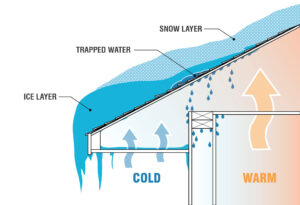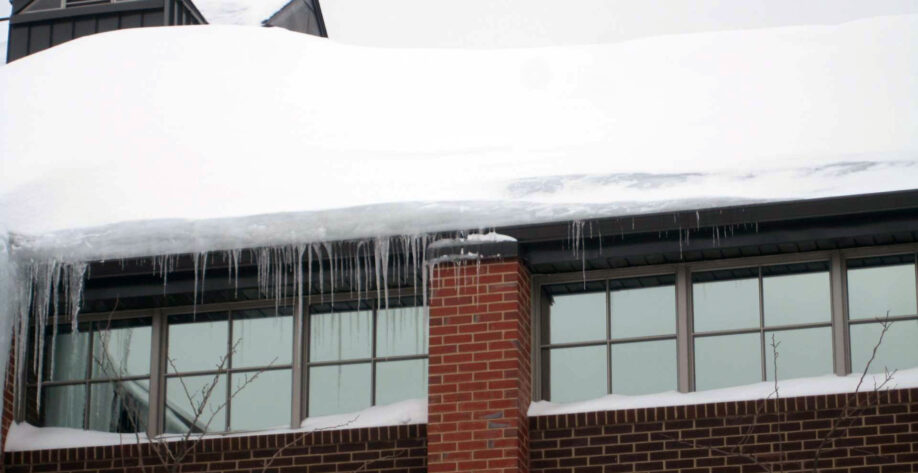Many of us who live in the northern states enjoy the change in seasons. We love winter for its beauty after freshly fallen snow and for the outside activities we can experience in the mountains or in our own backyards. But as with many of Mother Nature’s gifts, winter weather brings challenges to our buildings. Among the list are ice dams on roofs.
What Are Ice Dams on Roofs and How Do They Form?

Many of us have seen or experienced some form of an ice dam on roofs in our past and is usually evident in the form of large icicles or blocks of ice formed along the eaves of roofs.
In most cases, if you are experiencing one or the other then you may have an ice dam. With ice damming comes an increased risk of interior moisture infiltration that can cause damage of:
- Ceilings and finishes,
- Framing components,
- Exterior wall claddings. and
- Even the roof system and deck components
So, what is an ice dam on roofs and how/why does it form? Accumulated snow on roofs can actually act as an insulation layer. Heat from the underlying conditioned space, ambient heat, and solar radiation can contribute to melting the snow above the roof surface.
The melt water will run down the roof toward the eaves and gutters. When it reaches cold, un‐insulated overhangs, it freezes and forms a layer of ice. As this process continues, the ice height increases, creating a dam that impedes melt water from draining off the roof surface.
This ponded water backs up and flows under the dry laps in the shingles and underlayment, resulting in interior leakage and subsequent damage. The damage is most severe in areas with frequent freeze‐thaw cycles. Water that overflows the dam also creates icicles along the eave.
What Can Happen Next?
2020 has impacted all our lives enough, so we will keep this next part short as we only mention this in the spirit of being prepared. As the start of 2021 brings hope of a better year, it appears that Mother Nature’s weather pattern may still require us to stay on alert.
As some may know, polar vortices exist at the north and south poles and generally remain stable and unnoticed. The vortex is a low-pressure system that swirls cold air around the polar regions, approximately 18 miles above the planet.
However, at times these vortices become unstable during the winter months when warm pockets of air suddenly shift the vortex away from its usual location. These warm air pockets can cause the vortex to move or split and deliver prolonged periods of cold air and harsh weather to other parts of the globe.
If you have been following this process you might have read that a warm pocket of air recently influenced the vortex around the north pole. And as if weather in the northeast is not unpredictable enough, early weather maps indicate this region might be one of the most impacted by the splitting vortex’s resulting arctic blast.
We are not weather experts so a simple search online can give you additional information on the topic. What we do specialize in is roofs, including the methods of construction, and materials for keeping moisture out of buildings. If these forecasts on the vortex are correct, then understanding your building and how to be prepared will be of importance this winter.
What Can You Do To Be Prepared for Ice Damns on Roofs?
The purpose of this blog is not to scare the reader, as we do not expect the horrific scenes in the movie “The Day After Tomorrow” to be played out in real time. The purpose of this blog is to provide straight forward insight as to what to look for and to understand methods to reduce the potential for ice damming, before damage can occur.
There are several methods of preventing ice dams on roofs and subsequent damage, including:
- Insulating the ceiling line to keep attic space and roof surface cold.
- Ventilating the attic space or roof framing cavity to keep the attic cold.
- When re-roofing, specifying appropriate materials at possible ice dam locations to prevent leakage through roof underlayment laps.
- Heating portions of the roof that could be susceptible to ice dam formation.
You might be thinking: This advice is helpful if I had more time to implement some changes, but the potential change in weather patterns could occur in the next few weeks. How can I address these items quickly? Unfortunately, the answer at this time might be that you can’t, and long-term solutions need to wait. But that does not mean other proactive measures cannot be performed such as:
- Develop a monitoring plan to be implemented on a weekly basis or before and immediately following storms that have large temperature swings or heavy snow accumulations.
- Remove leaves, sticks, and other debris from gutters and downspouts to allow water to flow through the gutter and downspout systems as intended.
- Keep the snow load to a minimum on the roof, especially along eaves and overhangs. A roof rake (a long‐handled tool) allows a ground‐based user to pull the snow off the roof. Care is required so that the roof is not damaged during snow removal.
- Keep gutters and downspouts free of snow and ice formations, allowing a path for melted snow to exit the roof.
These methods are mentioned in an effort to reduce the potential of an ice dam on roofs from forming. If the ice dam has already formed, creating visible leaks, then it is best to have a qualified roofing contractor attempt to carefully remove the ice dam if possible.
Please keep in mind that direct ice removal with hammers, chisels, and shovels is not recommended due to the high probability of roof damage. The best method is to let it melt naturally if possible. Accessing a snow/ice covered roof should not be attempted.
Evaluation Techniques for Ice Damns on Roofs
For buildings with ice dam problems, a professional evaluation should be performed to determine the cause of the ice dams and the appropriate scope of repairs prior to the start of work. Typical repairs usually consist of improving the attic ventilation and/or ceiling insulation/vapor barrier.
Buildings with complicated roof framing or extensive mechanical systems in the attic make these types of repairs labor intensive, difficult to perform, and expensive. A less expensive option, on a temporary basis, is to provide heating elements to the roof surfaces at ice dam locations. A typical evaluation sequence includes the following elements:
- Review available drawings and other ice dam‐related documents.
- Observe site conditions (visual observations and destructive exploratory testing).
- Interior and exterior testing, as required.
- Develop options for repair.
Please reach out to us anytime, whether you are experiencing active leaks caused by ice dams, concerned with the potential for ice dams on roofs to occur, or require assistance with building envelope, structural engineering, or civil engineering needs.
Tagged In:
Building Enclosure Design & Consulting
